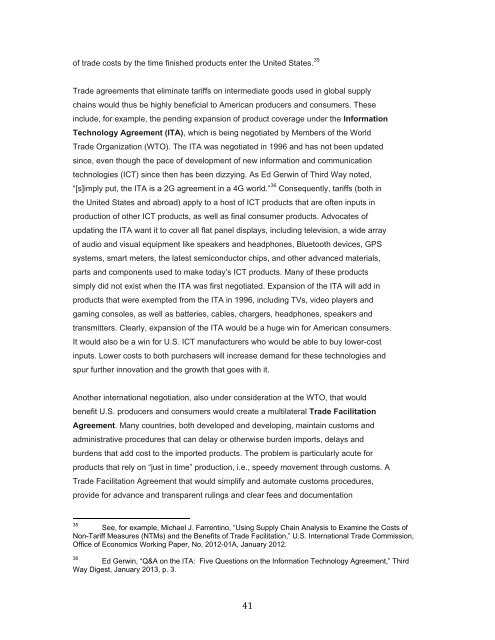You also want an ePaper? Increase the reach of your titles
YUMPU automatically turns print PDFs into web optimized ePapers that Google loves.
of trade costs by the time finished products enter the United States. 35<br />
Trade agreements that eliminate tariffs on intermediate goods used in global supply<br />
chains would thus be highly beneficial to American producers and consumers. These<br />
include, for example, the pending expansion of product coverage under the Information<br />
Technology Agreement (ITA), which is being negotiated by Members of the World<br />
Trade Organization (WTO). The ITA was negotiated in 1996 and has not been updated<br />
since, even though the pace of development of new information and communication<br />
technologies (ICT) since then has been dizzying. As Ed Gerwin of Third Way noted,<br />
“[s]imply put, the ITA is a 2G agreement in a 4G world.” 36 Consequently, tariffs (both in<br />
the United States and abroad) apply to a host of ICT products that are often inputs in<br />
production of other ICT products, as well as final consumer products. Advocates of<br />
updating the ITA want it to cover all flat panel displays, including television, a wide array<br />
of audio and visual equipment like speakers and headphones, Bluetooth devices, GPS<br />
systems, smart meters, the latest semiconductor chips, and other advanced materials,<br />
parts and components used to make today’s ICT products. Many of these products<br />
simply did not exist when the ITA was first negotiated. Expansion of the ITA will add in<br />
products that were exempted from the ITA in 1996, including TVs, video players and<br />
gaming consoles, as well as batteries, cables, chargers, headphones, speakers and<br />
transmitters. Clearly, expansion of the ITA would be a huge win for American consumers.<br />
It would also be a win for U.S. ICT manufacturers who would be able to buy lower-cost<br />
inputs. Lower costs to both purchasers will increase demand for these technologies and<br />
spur further innovation and the growth that goes with it.<br />
Another international negotiation, also under consideration at the WTO, that would<br />
benefit U.S. producers and consumers would create a multilateral Trade Facilitation<br />
Agreement. Many countries, both developed and developing, maintain customs and<br />
administrative procedures that can delay or otherwise burden imports, delays and<br />
burdens that add cost to the imported products. The problem is particularly acute for<br />
products that rely on “just in time” production, i.e., speedy movement through customs. A<br />
Trade Facilitation Agreement that would simplify and automate customs procedures,<br />
provide for advance and transparent rulings and clear fees and documentation<br />
35<br />
See, for example, Michael J. Farrentino, “Using Supply Chain Analysis to Examine the Costs of<br />
Non-Tariff Measures (NTMs) and the Benefits of Trade Facilitation,” U.S. International Trade Commission,<br />
Office of Economics Working Paper, No. 2012-01A, January 2012.<br />
36<br />
Ed Gerwin, “Q&A on the ITA: Five Questions on the Information Technology Agreement,” Third<br />
Way Digest, January 2013, p. 3.


